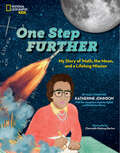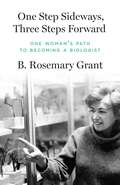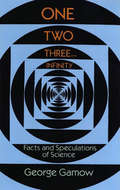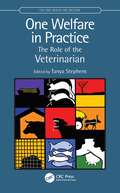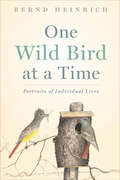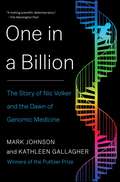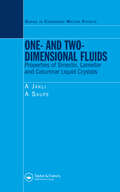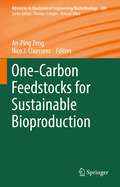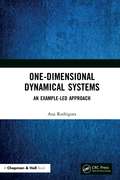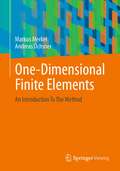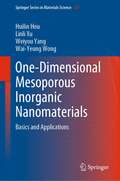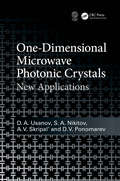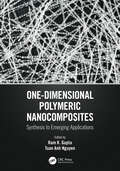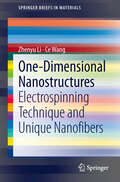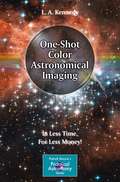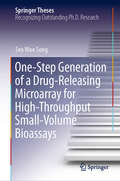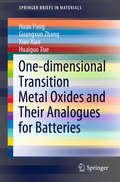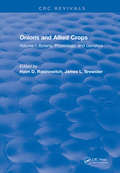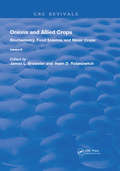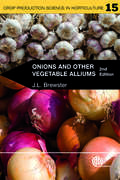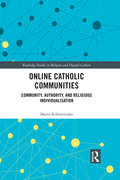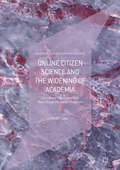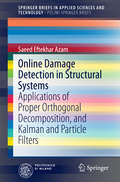- Table View
- List View
One Step Further: My Story of Math, the Moon, and a Lifelong Mission
by Katherine JohnsonThe only autobiographical account in picture book format of NASA mathematician Katherine Johnson's remarkable life tells the story of the Hidden Figures hero as you've never read it before. Lyrical, read-aloud text brings readers along on the journey as she rises above adversity to find her place among the stars.
One Step Sideways, Three Steps Forward: One Woman’s Path to Becoming a Biologist
by B. Rosemary GrantThe story of the unorthodox and inspiring life and career of a pioneering biologist Scientist Rosemary Grant&’s journey in life has involved detours and sidesteps—not the shortest or the straightest of paths, but one that has led her to the top of evolutionary biology. In this engaging and moving book, Grant tells the story of her life and career—from her childhood love of nature in England&’s Lake District to an undergraduate education at the University of Edinburgh through a swerve to Canada and teaching, followed by marriage, children, a PhD at age forty-nine, and her life&’s work with Darwin&’s finches in the Galápagos islands. Grant&’s unorthodox career is one woman&’s solution to the problem of combining professional life as a field biologist with raising a family.Grant describes her youthful interest in fossils, which inspired her to imagine another world, distant yet connected in time—and which anticipated her later work in evolutionary biology. She and her husband, Peter Grant, visited the Galápagos archipelago annually for forty years, tracking the fates of the finches on the small, uninhabited island of Daphne Major. Their work has profoundly altered our understanding of how a group of eighteen species has diversified from a single ancestral species, demonstrating that evolution by natural selection can be observed and interpreted in an entirely natural environment. Grant&’s story shows the rewards of following a winding path and the joy of working closely with a partner, sharing ideas, disappointments, and successes.
One Two Three . . . Infinity: Facts and Speculations of Science (Dover Books on Mathematics)
by George Gamow". . . full of intellectual treats and tricks, of whimsy and deep scientific philosophy. It is highbrow entertainment at its best, a teasing challenge to all who aspire to think about the universe." -- New York Herald TribuneOne of the world's foremost nuclear physicists (celebrated for his theory of radioactive decay, among other accomplishments), George Gamow possessed the unique ability of making the world of science accessible to the general reader.He brings that ability to bear in this delightful expedition through the problems, pleasures, and puzzles of modern science. Among the topics scrutinized with the author's celebrated good humor and pedagogical prowess are the macrocosm and the microcosm, theory of numbers, relativity of space and time, entropy, genes, atomic structure, nuclear fission, and the origin of the solar system.In the pages of this book readers grapple with such crucial matters as whether it is possible to bend space, why a rocket shrinks, the "end of the world problem," excursions into the fourth dimension, and a host of other tantalizing topics for the scientifically curious. Brimming with amusing anecdotes and provocative problems, One Two Three . . . Infinity also includes over 120 delightful pen-and-ink illustrations by the author, adding another dimension of good-natured charm to these wide-ranging explorations.Whatever your level of scientific expertise, chances are you'll derive a great deal of pleasure, stimulation, and information from this unusual and imaginative book. It belongs in the library of anyone curious about the wonders of the scientific universe. "In One Two Three . . . Infinity, as in his other books, George Gamow succeeds where others fail because of his remarkable ability to combine technical accuracy, choice of material, dignity of expression, and readability." -- Saturday Review of Literature
One Welfare in Practice: The Role of the Veterinarian (CRC One Health One Welfare)
by Tanya StephensAnimal welfare has long been recognised as central to the role of the veterinary professional, but this is increasingly aligned with the welfare of humans and the broader environment in which we co-exist. This is the first book dedicated to the role of the veterinarian in One Welfare, a concept that recognises the interconnections between animal welfare, human wellbeing, and the environment. The book demonstrates, through a wide range of international case studies, why professional ethics and the use of good evidence is integral to this role. Contributors bring a rich variety of writings, each with their own perception of the role of the veterinarian in improving animal welfare and human wellbeing. One Welfare in Practice: The Role of the Veterinarian emphasises the importance of interdisciplinary collaboration and solutions: it is essential that veterinary practitioners recognise when other professionals or disciplines need to be consulted to benefit both animals and humans. With its multiple, fascinating approaches to One Welfare, this book will inform and inspire the veterinarian to find areas where collaborative action reaps the greatest rewards. This unique book shows how veterinarians can and are contributing to improving animal and human welfare, offering practical advice as to how the profession can further engage in One Welfare in a range of settings.
One Wild Bird at a Time: Portraits of Individual Lives
by Bernd HeinrichUnique encounters with wild birds from the acclaimed scientist and &“a dedicated watcher happy to knock down the fourth wall of zoology&” (The Wall Street Journal). In his modern classics One Man&’s Owl and Mind of the Raven, Bernd Heinrich has written memorably about his relationships with wild ravens and a great horned owl. In One Wild Bird at a Time, Heinrich returns to his great love: close, day-to-day observations of individual wild birds. There are countless books on bird behavior, but Heinrich argues that some of the most amazing bird behaviors fall below the radar of what most birds do in aggregate. Heinrich&’s &“passionate observations [that] superbly mix memoir and science&” lead to fascinating questions—and sometimes startling discoveries (The New York Times Book Review). A great crested flycatcher, while bringing food to the young in their nest, is attacked by the other flycatcher nearby. Why? A pair of Northern flickers hammering their nest-hole into the side of Heinrich&’s cabin deliver the opportunity to observe the feeding competition between siblings, and to make a related discovery about nest-cleaning. One of a clutch of redstart warbler babies fledges out of the nest from twenty feet above the ground, and lands on the grass below. It can&’t fly. What will happen next? Heinrich &“looks closely, with his trademark &‘hands-and-knees science&’ at its most engaging, [delivering] what can only be called psychological marvels of knowing&” (The Boston Globe). &“An engaging memoir of the opportunities for doing scientific research without leaving one&’s own backyard.&”—Kirkus Reviews
One in a Billion: The Story of Nic Volker and the Dawn of Genomic Medicine
by Mark Johnson Kathleen GallagherThe breathtaking story of a young boy with a never-before-seen disease, and the doctors who take a bold step into the future of medicine to save him--based on the authors' Pulitzer Prize-winning reporting.In this landmark medical narrative, in the tradition of The Immortal Life of Henrietta Lacks and The Spirit Catches You and You Fall Down, Pulitzer Prize-winning journalists Mark Johnson and Kathleen Gallagher chronicle the story of Nic Volker, the Wisconsin boy at the center of a daring breakthrough in medicine--a complete gene sequencing to discover the cure for an otherwise undiagnosable illness. At just two years old, Nic experienced a searing pain that signaled the awakening of a new and deadly disease, one that would hurl Nic and his family up against the limits of modern medicine. For years, through false starts and failed cures, Nic holds on to life, buoyed up by his mother's fierce drive to get him the care he needs. But when even the world's experts are stumped by Nic's illness, his doctors come up with a radical, long-shot plan: a step into the unknown. The next major scientific frontier, following the completion of the Human Genome Project, was to figure out how to use our new knowledge to save lives--to bring genomic or personalized medicine into reality. It's a quest that is undertaken by researchers around the world. But it is only when geneticist Howard Jacob hears about young Nic that the finish line finally comes into sight: It's no longer a race to make history. It's a race to save this boy's life. One in a Billion is an unforgettable tale of the lives that converged to launch a medical revolution. As pioneering geneticist Mary-Claire King pronounced upon learning Nic's story: "It was as if one had heard about Case Zero of AIDS and the cure, all at once."
One of Us: Conjoined Twins and the Future of Normal
by Alice Domurat DregerMust children born with socially challenging anatomies have their bodies changed because others cannot be expected to change their minds? One of Us views conjoined twinning and other "abnormalities" from the point of view of people living with such anatomies, and considers these issues within the larger historical context of anatomical politics. Anatomy matters, Alice Domurat Dreger tells us, because the senses we possess, the muscles we control, and the resources we require to keep our bodies alive limit and guide what we experience in any given context. Her deeply thought-provoking and compassionate work exposes the breadth and depth of that context--the extent of the social frame upon which we construct the "normal." In doing so, the book calls into question assumptions about anatomy and normality, and transforms our understanding of how we are all intricately and inextricably joined.
One- and Two-Dimensional Fluids: Properties of Smectic, Lamellar and Columnar Liquid Crystals
by Antal Jakli A. SaupeSmectic and lamellar liquid crystals are three-dimensional layered structures in which each layer behaves as a two-dimensional fluid. Because of their reduced dimensionality they have unique physical properties and challenging theoretical descriptions, and are the subject of much current research. One- and Two-Dimensional Fluids: Properties of Smec
One-Carbon Feedstocks for Sustainable Bioproduction (Advances in Biochemical Engineering/Biotechnology #180)
by An-Ping Zeng Nico J. ClaassensThis book offers a comprehensive review of the latest developments, challenges and trends in C1-based (one-carbon based) bioproduction, and it presents an authoritative account of one-carbon compounds as promising alternative microbial feedstocks. The book starts with a perspective on the future of C1 compounds as alternative feedstocks for microbial growth, and their vital role in the establishment of a sustainable circular carbon economy, followed by several chapters in which expert contributors discuss about the recent strategies and address key challenges regarding one or more C1 feedstocks. The book covers topics such as acetogenic production from C1 feedstocks, aerobic carboxydotrophic bacteria potential in industrial biotechnology, bioconversion of methane to value-added compounds, combination of electrochemistry and biology to convert C1 compounds, and bioprocesses based on C1-mixotrophy. Particular attention is given to the current metabolic engineering, systems biology, and synthetic biology strategies applied in this field.
One-Dimensional Dynamical Systems: An Example-Led Approach
by Ana RodriguesFor almost every phenomenon in physics, chemistry, biology, medicine, economics, and other sciences, one can make a mathematical model that can be regarded as a dynamical system. One-Dimensional Dynamical Systems: An Example-Led Approach seeks to deep-dive into α standard maps as an example-driven way of explaining the modern theory of the subject in a way that will be engaging for students. Features Example-driven approach Suitable as supplementary reading for a graduate or advanced undergraduate course in dynamical systems
One-Dimensional Finite Elements: An Introduction To The Method
by Andreas Öchsner Markus MerkelThe basic idea of this introduction to the finite element method is based on the concept of explaining the complex method using only one-dimensional elements. Thus, the mathematical description remains largely simple and straightforward. The emphasis in each chapter is on explaining the method and understanding it itself. The reader learns to understand the assumptions and derivations in various physical problems in structural mechanics and to critically assess the possibilities and limitations of the finite element method.The restriction to one-dimensional elements thus enables the methodical understanding of important topics (e.g. plasticity or composite materials), which a prospective computational engineer encounters in professional practice, but which are rarely treated in this form at universities. Thus, an easy entry - also into more advanced application areas - is ensured by the concept of (a) introduction to the basics (b) exact derivation with restriction to one-dimensional elements (and in many cases also to one-dimensional problems) (c) extensive examples and advanced tasks (with short solution in the appendix).For illustration purposes, each chapter is deepened with extensively calculated and commented examples as well as with further tasks including short solutions
One-Dimensional Mesoporous Inorganic Nanomaterials: Basics and Applications (Springer Series in Materials Science #321)
by Wai-Yeung Wong Huilin Hou Linli Xu Weiyou YangThis book provides a comprehensive look at one-dimensional (1D) mesoporous inorganic nanomaterials. Beginning with a systematic presentation of their characterization using advanced electron microscopy techniques, the book discusses how to design the growth of 1D nanomaterials in order to achieve different, application-targeted morphologies such as nanowires, nanorods, nanofibers, nanotubes, and nanobelts. Subsequently, the book systematically summarizes current state-of-the-art research activities, encompassing energy conversion and storage, catalysis, sensing, and adsorption. The book concludes with a forward-looking summary of the different prospects of these materials for novel energy applications, as well as the challenges faced regarding their mass production, cost-effective synthesis strategies, and a deep understanding of the physics involved in the microstructure-dependent performance. Featuring broad and up-to-date coverage of this rapidly growing field, this book is useful for researchers working at the intersections of materials science, chemistry, and advanced energy devices.
One-Dimensional Microwave Photonic Crystals: New Applications
by D. A. Usanov S. A. Nikitov A. V. Skripal D. V. PonomarevExplores theoretical and experimental studies of the properties of one-dimensional photonic crystals. The authors also consider the possibilities of controlling the characteristics of microwave photonic crystals with the help of electric and magnetic fields and provide examples of new fields of application of microwave photonic crystals. They review measurements of the parameters of layered structures containing nanometer-sized semiconductor and metal layers and explore microwave-compatible loads. Written for specialists and scientists working in the fields of radiophysics, microwave solid-state electronics, and microwave photonics. <P><P>Key selling features: <li>Presents studies of theoretical and experimental properties of one-dimensional photonic crystals <li>Analyzes microwave photonic crystals based on flat transmission lines. <li>Explores the use of electric and magnetic fields to control crystal characteristics. <li>Reviews applications of photonic crystals in semiconductors. <li>Examines one-dimensional microwave photonic crystals based on rectangular wave guides.
One-Dimensional Polymeric Nanocomposites: Synthesis to Emerging Applications
by Ram K. GuptaOne-dimensional nanomaterials are emerging as promising materials for their many unique characteristics. This book covers their synthesis and applications in batteries, supercapacitors, fuel cells, solar cells, green energy production, flexible electronics, electrochemical sensors, and biomedicine. Progress in nanotechnology offers an opportunity to synthesize materials with unique properties. The properties of nanomaterials can be further improved by growing them in one-dimension structural with variations in their architecture. One-dimensional polymeric nanocomposites offer various advantages such as nano dimensions, high surface area, structural stability, and the ability to tune their electrochemical, electronic, and optical properties. The book covers basic concepts, chemistries, properties, and the importance of one-dimensional nanomaterials, along with their wide applications and state-of-the-art progress in the energy, flexible electronics, sensor, and biomedical fields. The fundamentals of electrochemical behavior and their understanding for various applications are also discussed in detail. This book will provide new direction to scientists, researchers, and students to better understand the chemistry, technologies, and applications of one-dimensional polymeric nanocomposites.
One-Dimensional nanostructures
by Ce Wang Zhenyu LiOne-Dimensional Nanostructures: Electrospinning Technique and Unique Nanofibers is a comprehensive book depicting the electrospinning technique and related 1D unique electrospun nanofibers. The first part of the book focuses on electrospinning technique, with chapters describing Electrospinning setup, electrospinning theories, and related working parameter. The second part of the book describes in detail specific topics on how to control the electrospun fiber properties such as how to control the fiber direction, how to control the fiber surface morphology, how to control the fiber structure, and how to construct 3D structures by electrospun fibers. The final part of the book depicts the applications of the electrospun nanofibers, with sections describing in detail specific fields such as electrospun nanofiber reinforcement, filtration, electronic devices, lithium-ion batteries, fuel cells, biomedical field, and so on. One-Dimensional Nanostructures: Electrospinning Technique and Unique Nanofibers is designed to bring state-of-the-art on electrospinning together into a single book and will be valuable resource for scientists in the electrospinning field and other scientists involved in biomedical field, mechanical field, materials, and energy field. Dr. Zhenyu Li is an associate professor at the Dept. of Chemistry, Jilin University, Changchun, P. R. China. Currently, he also holds the position in Australian Future Fibres Research & Innovation Centre, Institute for Frontier Materials, Deakin University, Geelong, Victoria, Australia. Dr. Ce Wang is a professor at the Dept. of Chemistry, Jilin University, Changchun, P. R. China.
One-Shot Color Astronomical Imaging
by L. A. KennedyThis book shows amateur astronomers how to use one-shot CCD cameras, and how to get the best out of equipment that exposes all three color images at once. Because this book is specifically devoted to one-shot imaging, "One-Shot Color Astronomical Imaging" begins by looking at all the basics - what equipment will be needed, how color imaging is done, and most importantly, what specific steps need to be followed after the one-shot color images are taken. What is one-shot color imaging? Typically, astronomical cooled-chip CCD cameras record only one color at a time - rather like old-fashioned black & white cameras fitted with color filters. Three images are taken in sequence - in red, blue, and green light - and these are then merged by software in a PC to form a color image. Each of the three images must be taken separately through a suitable color filter, which means that the total exposure time for every object is more than tripled. When exposure times can run into tens of minutes or even hours for each of the three colors, this can be a major drawback for the time-pressed amateur. "One-Shot Color Astronomical Imaging" describes the most cost-effective and time-efficient way for any amateur astronomer to begin to photograph the deep-sky.
One-Step Generation of a Drug-Releasing Microarray for High-Throughput Small-Volume Bioassays (Springer Theses)
by Seo Woo SongThis thesis demonstrates a technology that enables pipetting-free high-throughput screening (HTS) on a miniaturized platform, eliminating the need for thousands of one-by-one pipetting and conventional liquid handling systems. This platform enhances accessibility to HTS and enables HTS to be used in small-to-medium scale laboratories. In addition, it allows large-scale combinatorial screening with a small number of valuable cells, such as patients’ primary cancer cells. This technique will have a high impact for widespread use of HTS in the era of personalized medicine. In this thesis, the author firstly describes the need and concept of ‘partipetting’ for pipetting-free HTS platform. It is realized by the one-step pipetting and self-assembly of encoded drug-laden microparticles (DLPs) on the microwells. Next, the technical implementations required for the platform demonstration are described. It includes preparation of encoded DLPs, plastic chip fabrication, and realization of automated system. Lastly, screening of sequential drug combinations using this platform is demonstrated. This shows the potential of the proposed technology for various applications.
One-dimensional Transition Metal Oxides and Their Analogues for Batteries (SpringerBriefs in Materials)
by Xiao Xiao Huan Pang Guangxun Zhang Huaiguo XueThis book highlights the use of one-dimensional transition metal oxides and their analogue nanomaterials for battery applications. The respective chapters present examples of one-dimensional nanomaterials with different architectures, as well as a wide range of applications, e.g. as electrode materials for batteries. The book also addresses various means of synthesizing one-dimensional nanomaterials, e.g. electrospinning, the Kirkendall effect, Ostwald ripening, heterogeneous contraction, liquid-phase preparation, the vapor deposition approach and template-assisted synthesis. In closing, the structural design, optimization and promotion of one-dimensional transition metal oxide electrode materials are discussed. The book chiefly focuses on emerging configurable designs, including core-shell architectures, hollow architectures and other intricate architectures. In turn, the applications covered reflect essential recent advances in many modern types of battery. Accordingly, the book offers an informative and appealing resource for a wide readership in various fields of chemical science, materials and engineering.
Onions and Allied Crops: Volume I: Botany, Physiology, and Genetics
by H.D. RabinowitchFirst Published in 2018. Routledge is an imprint of Taylor & Francis, an Informa company.
Onions and Allied Crops: Volume III: Biochemistry, Food Science, and Minor Crops
by James L. Brewster H.D. RabinowitchOriginally published in 1990, Onions and Allied Crops, is a comprehensive account of the edible allium, examined across three volumes. The collection examines the major economic and dietary importance of edible alliums in most countries, and brings together contributions from experts across multiple disciplines, including food scientists, economists, agriculturalists and biochemists. The books address selection and breeding of locally adapted cultivars and the development of cultural techniques, allowing for cultivation across the tropics, to the sub-arctic regions. As such the collection examines the allium as a major agricultural asset and the impact this has had on many economies. In this third volume, the analysis and focus is upon biochemistry, food science and minor crops. This volume will be of use and of interest to food scientists, economists, agriculturalists and biochemists alike.
Onions and Other Vegetable Alliums
by James BrewsterThis fully revised, expanded and updated edition of the successful text, Onions and Other Vegetable Alliums, relates the production and utilization of these familiar and important vegetable crops to the many aspects of plant science underpinning their production and storage technologies. Chapters cover species and crop types, plant structure, genetics and breeding, physiology of growth and development as well as pests and diseases, production agronomy, storage after harvest and the biochemistry of flavour, storage carbohydrates and colour and how this relates to nutritional and health benefits. From this wide perspective it is possible to see many examples where underlying scientific knowledge illuminates, explains and can improve agronomic practice. The reader will get an insight into how molecular methods are revolutionizing the study of taxonomy, genetics, pathology and physiology and how these methods are being applied in the breeding of improved crops.
Onions and Other Vegetable Alliums (2nd edition)
by James L. BrewsterThis edition relates the production and utilization of the familiar and important vegetable crops to the many aspects of plant science underpinning their production and storage technologies. Chapters cover species and crop types, plant structure, genetics and breeding, physiology of growth and development and also pests and diseases, production agronomy, storage after harvest and the biochemistry of flavor, storage carbohydrates and color and how this relates to nutritional and health benefits.
Online Catholic Communities: Community, Authority, and Religious Individualization (Routledge Studies in Religion and Digital Culture)
by Marta KołodziejskaThe Catholic Church has been moving into a new phase, one where its congregation can choose to meet and practice elements of their own version of their faith on online forums. This new form of congregating allows for an individualised faith to manifest itself outside of the usual church authority structures. Online Catholic Communities provides insight into how religious and non-religious internet forum users interact and form groups during interactions; it also discusses the transformation of religious authority and its emanations in these digital contexts. Using the top three online forums used by Polish Catholics as a case study, this project explores the formation of these online communities. It then looks at the alternative authority structures that emerge online and how these lead to an individualised form of religious engagement that can develop independently of mainstream doctrine. Through highlighting how religious discourse in Poland is appropriated and creatively modified by users in fulfilling their own spiritual needs, this work reveals the constant interplay between online and offline religious contexts. This monograph includes cutting edge research on online expressions of religious community, authority and individualisation and as such will be of keen interest to scholars of religious studies and the sociology of religion, as well as communication studies.
Online Citizen Science and the Widening of Academia: Distributed Engagement With Research And Knowledge Production (Palgrave Studies In Alternative Education Ser.)
by Vickie CurtisThis book examines the increasing popularity of online citizen science projects arising from developments in ICT and rapid improvements in data storage and generation. As these new technologies allow for much higher levels of participation, collaboration and interaction, the author explores what online citizen science projects reveal about the ‘democratisation’ of science and distributed engagement with authentic research. Analysing the wider appeal of these projects as well as their potential for informal science learning and creating communities of practice, this book asks whether ‘citizen’ and ‘researcher’ will ever be on equal footing. Drawn from years of mixed-methods research, this volume sheds light on this under-researched subject area despite its recent growth and enormous potential. It is sure to be of interest to students and scholars of democratised knowledge, citizen science and online learning, as well as those already involved in citizen science.
Online Damage Detection in Structural Systems
by Saeed Eftekhar AzamThis monograph assesses in depth the application of recursive Bayesian filters in structural health monitoring. Although the methods and algorithms used here are well established in the field of automatic control, their application in the realm of civil engineering has to date been limited. The monograph is therefore intended as a reference for structural and civil engineers who wish to conduct research in this field. To this end, the main notions underlying the families of Kalman and particle filters are scrutinized through explanations within the text and numerous numerical examples. The main limitations to their application in monitoring of high-rise buildings are discussed and a remedy based on a synergy of reduced order modeling (based on proper orthogonal decomposition) and Bayesian estimation is proposed. The performance and effectiveness of the proposed algorithm is demonstrated via pseudo-experimental evaluations.
